Search the Special Collections and Archives Portal
Search Results
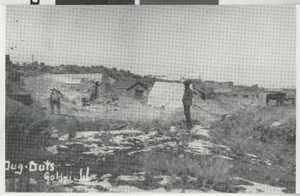
Postcard of dugout houses in Goldfield (Nev.), 1904
Date
1904
Archival Collection
Description
In most central Nevada mining camps, building materials were scarce during early development. Empty bottles, cans and stones were used to fabricate dwellings. In Goldfield, dugout homes were built into the walls of the two largest washes that crossed the townsite. The dugouts were cool in the summer and warm in the winter. The major disadvantage was size. Most were limited to one room. As building materials became available, conventional housing soon replaced the dugouts. The majority of Goldfield's dugouts were destroyed in the flood of 1923, although a few can still be found in the smaller washes on the west edge of town.
Image
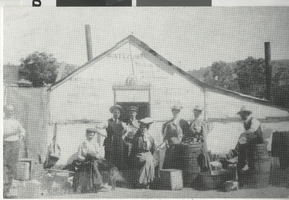
Postcard of a tent store, Montezuma (Nev.), 1908
Date
1908
Archival Collection
Description
Montezuma was the site of extensive mining activity from the 1860s-1880s but was dormant in the early 1900s when the Goldfield strike was made. According to the information painted on the front of the "Road House" of the "Montezuma Trading Company", the traveler or prospector could purchase "Wines & Liquors, Tobacco, Miners Supplies, Hay & Grain, and Groceries" at the store. Montezuma was located in the Montezuma Mountains seven miles west of Goldfield and was experiencing a resurgence precipitated by the discoveries at Goldfield.
Image
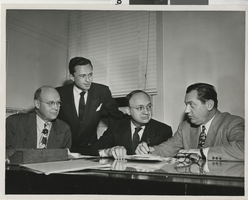
Photograph of Bill Heineman, Lloyd Katz, and two unidentified men in San Francisco (Calif.), 1947-1948
Date
1947 to 1948
Archival Collection
Description
Black and white image of Bill Heineman (far right) CEO of Eagle-Lion Films and Lloyd Katz (standing) manager of Eagle-Lion Films in San Francisco, California 1947-1948.
Image
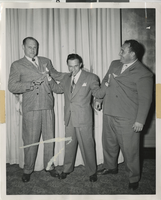
Photograph of Lloyd Katz in San Francisco (Calif.), 1947-1948
Date
1947 to 1948
Archival Collection
Description
Black and white image of Lloyd Katz (center) with two men in San Francisco, California, 1947-1948.
Image
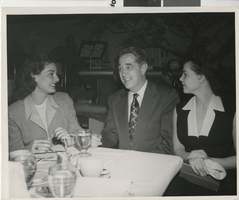
Photograph of Nevada Governor Charles Hinton Russell with two unidentified women in Las Vegas (Nev.), February 12, 1952
Date
1952-02-12
Archival Collection
Description
Black and white image of Nevada Governor, Charles Hinton Russell with two women, Las Vegas, Nevada, February 12, 1952.
Image
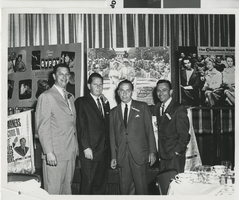
Photograph of Lloyd Katz with three unidentified men, early 1960s
Date
1960 to 1963
Archival Collection
Description
Black and white image of Lloyd Katz (far right) with three men, early 1960s.
Image
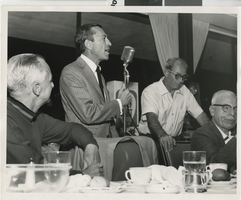
Photograph of Lloyd Katz at the Variety Golf Tournament in San Francisco (Calif.), October 1967
Date
1967-10
Archival Collection
Description
Black and white image of Lloyd Katz (speaking) at the Variety Golf Tournament at Lake Merced Country Club in San Francisco, California October 1967.
Image
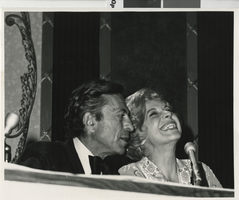
Photograph of Lloyd Katz and Muriel Stevens in Las Vegas (Nev.), April 1972
Date
1972-04
Archival Collection
Description
Black and white image of Lloyd Katz and Muriel Stevens at the Channel 10 Fundraiser in Las Vegas, Nevada April 1972.
Image
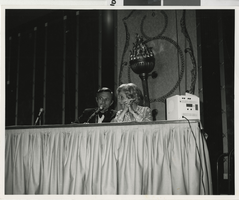
Photograph of Lloyd Katz and Muriel Stevens in Las Vegas (Nev.), April 1972
Date
1972-04
Archival Collection
Description
Black and white image of Lloyd Katz and Muriel Stevens at the Channel 10 Fundraiser in Las Vegas, Nevada April 1972.
Image
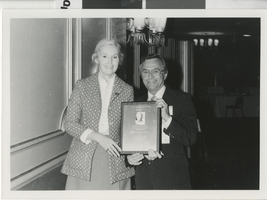
Photograph of Lloyd Katz and Tichi Wilkerson Miles, September 1976
Date
1976-09
Archival Collection
Description
Black and white image of Lloyd Katz standing with Tichi Wilkerson Miles displaying a plaque in her honor, September 1976.
Image
Pagination
Refine my results
Content Type
Creator or Contributor
Subject
Archival Collection
Digital Project
Resource Type
Year
Material Type
Place
Language
